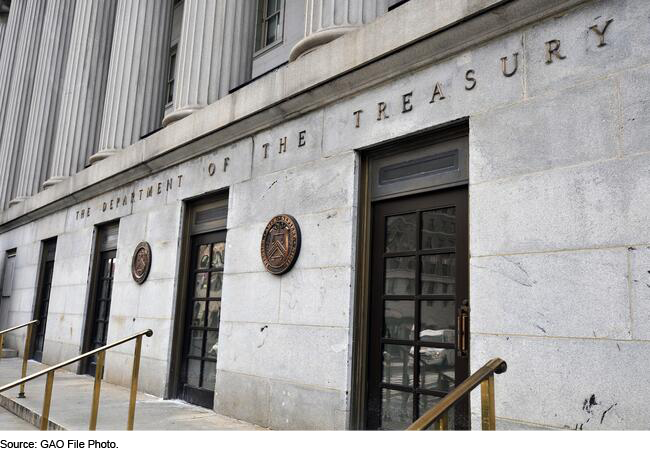Community Development Financial Institutions: Analysis of Annual and Emergency Assistance and Treasury Efforts to Address Program Risks
Fast Facts
People in low- and moderate-income communities don't always have access to traditional financial institutions, like large banks. Community Development Financial Institutions are smaller, community-based organizations that provide financial services to help fill this gap.
The Department of the Treasury receives federal funding to support these institutions—including $12 billion in emergency COVID-19 support in FY 2021.
To help this support reach more communities, Treasury allowed higher-risk institutions to apply for a portion of the funding. Treasury required these institutions to undergo a more stringent review.

Highlights
What GAO Found
Community development financial institutions (CDFI) and minority depository institutions (MDI) provide financial services to underserved communities. The Department of the Treasury assists eligible institutions through annual CDFI Program awards. Treasury received additional funds in 2021 for three COVID-19-related assistance programs—Rapid Response Program, Emergency Capital Investment Program, and Equitable Recovery Program (see table). GAO found that awards for the first two of these programs were larger than typical CDFI Program awards, which had a median of $400,000 in fiscal year 2021.
Status of Awards from Treasury's Emergency Assistance Programs for Community Development Financial Institutions and Minority Depository Institutions
|
Program |
Amount appropriated |
Status |
Primary recipients (percentage of all recipients) |
Median award |
|---|---|---|---|---|
|
Rapid Response Program |
$1.25 billion |
Fully disbursed |
Loan funds (54%); credit unions (28%) |
$1.83 million |
|
Emergency Capital Investment Program |
$9.00 billion |
$8.28 billion disbursed as of Sept. 21, 2022 |
Banks, savings associations, and holding companies (57%); credit unions (43%) |
$29.94 million |
|
Equitable Recovery Program |
$1.75 billion |
Not yet awarded |
Not applicable |
Not applicable |
Source: GAO and Department of the Treasury. | GAO-23-105952
GAO's analysis of CDFI Program and Rapid Response Program data found that recipients have used awards mainly to provide financial products and to increase reserves. Financial products provided by CDFI Program recipients in fiscal years 2016–2020 mainly funded home purchases, businesses, and microenterprises.
Treasury took steps to address potential risks to program integrity created by aspects of the emergency programs. For example:
- Risk-based application reviews. Treasury allowed higher-risk institutions to be eligible for the Rapid Response Program and the Equitable Recovery Program to be inclusive of institutions from more communities (e.g., those with low levels of bank deposits). To address potential risks, Treasury's process called for additional reviews of such applicants.
- Ability-to-pay requirement. The Emergency Capital Investment Program requires recipients to pay Treasury dividends or interest in exchange for a capital investment. To help ensure recipients can pay the amounts due, Treasury required institutions to have at least a 1-to-1 ratio of net income to the dividend or interest amount to be eligible for an investment.
Treasury is also developing a risk-based process for reviewing Rapid Response Program and Equitable Recovery Program recipients and is finalizing policies for post-award reporting and award monitoring for the Emergency Capital Investment Program. These efforts are intended to monitor whether the funds are being used as intended.
Why GAO Did This Study
Access to credit and capital is vital to economic development but is limited in many low- and moderate-income communities underserved by traditional financial institutions. The economic effects of the COVID-19 pandemic have further stressed these communities, which often rely on CDFIs and MDIs—generally smaller, community-based organizations—for financial products and services.
The Consolidated Appropriations Act, 2021, appropriated $188 million to Treasury's existing CDFI Program and supplemental programs. It also appropriated $12 billion in emergency assistance for three new Treasury programs designed to help CDFIs and MDIs respond to the impacts of COVID-19, most of which has been awarded. Two of the new programs required Treasury to award funds expeditiously.
GAO was asked to assess Treasury's distribution of funds, efforts to ensure program integrity, and the use of Treasury's funding. This report examines (1) the types of institutions that received funds from the CDFI Program or the 2021 emergency programs and how much they received, (2) how recipients have used CDFI Program and Rapid Response Program funds, and (3) steps Treasury took to address risks posed by the emergency programs.
To conduct this work, GAO analyzed Treasury data, reviewed Treasury policies and procedures, and interviewed Treasury officials.
For more information, contact William B. Shear at (202) 512-8678 or ShearW@gao.gov.
